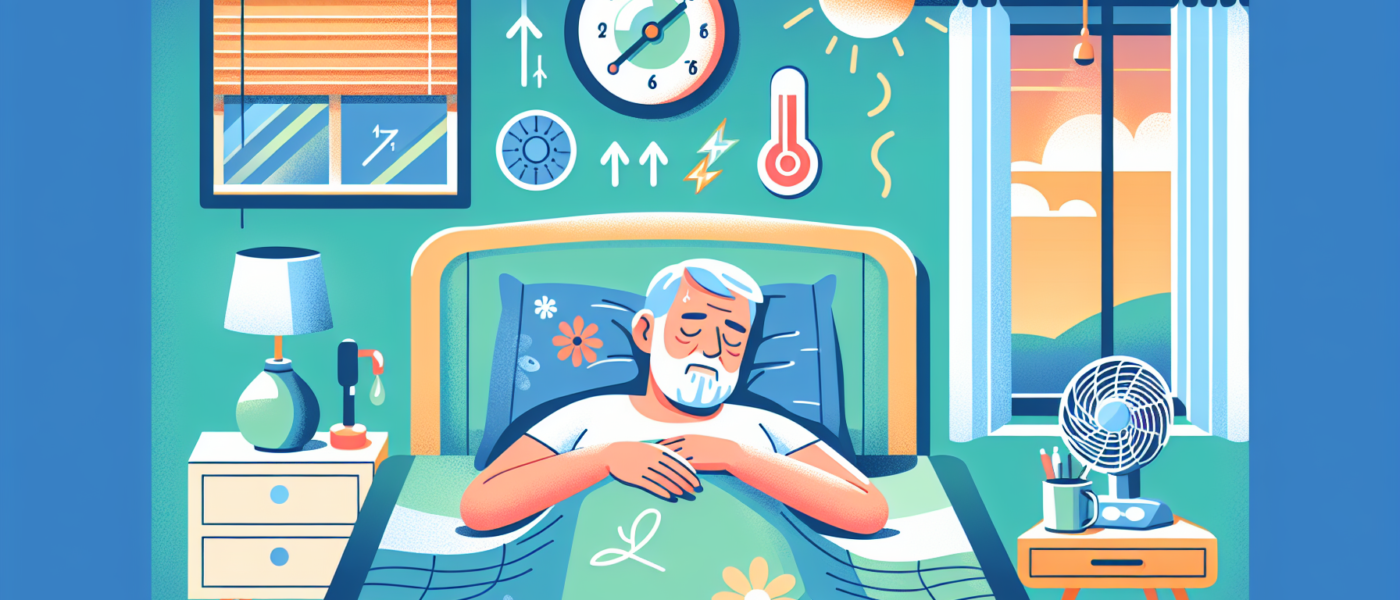Temperature Regulation for Optimal Sleep in Aging Men
Key Takeaways
- Temperature plays a critical role in sleep quality, especially for aging men.
- Understanding the relationship between body temperature and sleep cycles can improve sleep quality.
- Practical temperature regulation strategies can enhance sleep for older adults.
The Importance of Temperature in Sleep
Sleep is a fundamental aspect of human health, influencing everything from cognitive function to emotional well-being. For aging men, achieving high-quality sleep can become increasingly challenging. One of the most critical yet often overlooked factors affecting sleep quality is temperature regulation. Understanding the connection between body temperature and sleep cycles can help aging men and those who care for them create optimal sleeping environments.
Understanding the Sleep Cycle
The sleep cycle is a complex interplay of various stages, typically categorized into Rapid Eye Movement (REM) and Non-REM (NREM) sleep. These stages repeat in cycles throughout the night, each lasting about 90 minutes. NREM sleep consists of three stages, progressing from light to deep sleep, while REM sleep is associated with vivid dreams and brain activity similar to wakefulness.
Body temperature undergoes natural fluctuations throughout the day, reaching its lowest point during the early morning hours. These variations are part of the circadian rhythm, the internal body clock that regulates sleep-wake cycles. For optimal sleep, it is crucial to align body temperature with the natural progression of the sleep cycle.
Temperature Regulation in Aging Men
As men age, physiological changes can disrupt sleep patterns, making it more challenging to achieve restful sleep. Hormonal changes, reduced production of melatonin, and age-related medical conditions can contribute to sleep disturbances. Moreover, aging affects the body’s ability to regulate temperature efficiently. This can lead to difficulty falling asleep, fragmented sleep, and wakefulness during the night.
Studies have shown that older adults often experience a decrease in core body temperature during sleep, making them more sensitive to environmental temperature changes. This heightened sensitivity underscores the importance of creating a sleep environment that supports optimal temperature regulation.
Ideal Sleeping Temperature
Research indicates that the ideal bedroom temperature for sleep is between 60-67 degrees Fahrenheit (15-19 degrees Celsius). This range supports the natural decline in body temperature that facilitates the onset of sleep. For aging men, maintaining this temperature range can be particularly beneficial, as it aligns with the body’s circadian rhythm and enhances sleep quality.
However, individual preferences and needs can vary. Some men may find slightly cooler or warmer temperatures more comfortable. It is essential to pay attention to personal comfort and make adjustments accordingly.
Practical Strategies for Temperature Regulation
Creating an optimal sleep environment involves more than setting the thermostat. Various factors can influence bedroom temperature and personal comfort. Here are some practical strategies for aging men to regulate temperature effectively:
1. Bedding and Sleepwear
Choosing the right bedding and sleepwear can significantly impact sleep quality. Opt for breathable, moisture-wicking fabrics such as cotton or bamboo that help regulate body temperature. Layering bedding allows for easy adjustments based on personal comfort and environmental conditions. A light blanket can provide warmth without overheating, while an extra layer can be added if needed.
2. Mattress and Pillow Selection
The choice of mattress and pillow can also affect temperature regulation. Memory foam mattresses, while comfortable, can retain heat. Look for mattresses designed with cooling technology, such as gel-infused foam or breathable materials that promote airflow. Similarly, pillows made from cooling materials can help dissipate heat and enhance comfort.
3. Room Ventilation
Proper ventilation is crucial for maintaining an optimal sleep environment. Ensure adequate airflow by opening windows or using fans to circulate air. Air conditioners and dehumidifiers can also help regulate temperature and humidity levels. It is important to avoid excessive humidity, as it can disrupt sleep and lead to discomfort.
4. Pre-Sleep Routine
Establishing a consistent pre-sleep routine can signal the body that it is time to wind down and prepare for sleep. Taking a warm bath or shower before bed can raise body temperature temporarily, followed by a gradual decline that promotes sleepiness. Engaging in relaxing activities such as reading or listening to soothing music can also aid in relaxation and temperature regulation.
5. Hydration and Nutrition
Staying hydrated is essential for overall health and can influence body temperature regulation. Drinking a glass of water before bed can help maintain hydration levels through the night. It is also advisable to avoid heavy meals, caffeine, and alcohol close to bedtime, as these can interfere with sleep and temperature regulation.
6. Sleep Schedule Consistency
Maintaining a consistent sleep schedule reinforces the body’s circadian rhythm, promoting better temperature regulation. Go to bed and wake up at the same time every day, even on weekends. Consistency helps the body naturally adjust to temperature changes and improve overall sleep quality.
Monitoring and Adjusting the Sleep Environment
Temperature regulation is a dynamic process that may require ongoing adjustments. Aging men can benefit from monitoring their sleep environment and making necessary changes to optimize comfort. Keep a sleep diary to track how different temperature settings and environmental factors impact sleep quality. This information can guide adjustments and help identify patterns or triggers that disrupt sleep.
Smart home technology can also assist in maintaining an optimal sleep environment. Programmable thermostats, smart fans, and sleep-tracking devices provide valuable data and automate temperature adjustments based on individual preferences and sleep patterns.
Conclusion
Temperature regulation is a key factor in achieving optimal sleep, particularly for aging men who may face unique challenges due to physiological changes. Understanding the relationship between body temperature and sleep cycles can help create an environment conducive to restful sleep. Implementing practical strategies, such as choosing appropriate bedding, ensuring proper ventilation, and establishing a consistent sleep routine, can significantly improve sleep quality.
As each individual is unique, it is essential to pay attention to personal comfort and make necessary adjustments to the sleep environment. By prioritizing temperature regulation and adopting healthy sleep habits, aging men can enhance their well-being and enjoy the restorative benefits of high-quality sleep.

